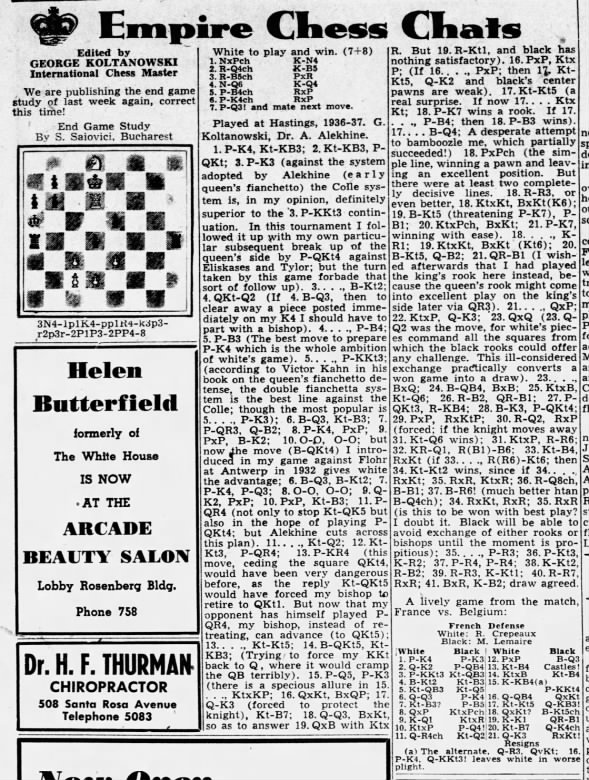 Chess Chats Sun, Feb 26, 1950 – 24 · The Press Democrat (Santa Rosa, California) · Newspapers.com
Chess Chats Sun, Feb 26, 1950 – 24 · The Press Democrat (Santa Rosa, California) · Newspapers.com
We are publishing the end game study of last week again, correct this time! End Game Study by S. Saiovici, Bucharest
Chess Chats by George Koltanowski Sunday, February 19, 1950 The Press Democrat Santa Rosa, California End Game Study by...
Posted by Bobby Fischer's True History on Tuesday, March 31, 2020
End Game Study by S. Saiovici, Bucharest. White to play and win.
FEN 3N4/1p1K4/pp1R4/k3p3/r2p3r/2P1P3/2PP4/8 w - - 0 1
1. NxPch K-N4
2. R-Q4ch K-B5
3. R-B5ch PxR
4. N-Q6 K-Q4
5. P-B4ch RxP
6. P-K4ch RxP
7. P-Q3! and mate next move.
Georges Koltanowski vs Alexander Alekhine
Hastings (1936/37), Hastings ENG, rd 9, Jan-06
Indian Game: Capablanca Variation (A47) 1/2-1/2
3. against the system adopted by Alekhine (early queen's fianchetto) the Colle system is, in my opinion, definitely superior to the 3. P-KKt3 continuation. In this tournament I followed it up with my own particular subsequent break up of the queen's side by P-QKt4 against Eliskases and Tylor; but the turn taken by this game forbade that sort of follow up.
4. If 4. B-Q3, then to clear away a piece posted immediately on my K4 I should have to part with a bishop.
5. The best move to prepare P-K4 which is the whole ambition of white's game.
5. ... according to Victor Kahn in his book on the queen's fianchetta system is the best line against the Colle; through the most popular is 5. ... P-K3.
10. ... but now the move (B-QKt4) I introduced in my game against Flohr at Antwerp in 1932 gives white the advantage; 6. B-Q3 B-Kt2; 7. P-K4 P-Q3; 8. O-O O-O; 9. Q-K2 PxP; 10. PxP Kt-B3;
11. not only to stop Kt-QK5 but also in the hope of playing P-QKt4; but Alekhine cuts across this plan.
13. this move, ceding the square QKt4, would have been very dangerous before, as the reply Kt-QKt5 would have forced my bishop to retire to QKt1. But now that my opponent has himself played P-QR4, my bishop, instead of retreating, can advance to QKt5.
14. ... Trying to force my KKt back to Q, where it would cramp the QB terribly.
15. there is a specious allure in 15. ... KtxKP;
17. forced to protect the knight.
18. ... so as to answer 19. QxB with KtxR. But 19. R-Kt1, and black has nothing satisfactory). 16. PxP KtxP; (If 16. ... PxP; then 17. Kt-Kt5, Q-K2 and black's center pawns are weak.) 17. Kt-Kt5 (a real surprise. If now 17. ... KtxKt; 18. P-K7 wins a rook. If 17. ... P-B4; then 18. P-B3 wins.) 17. ... B-Q4; A desperate attempt to bamboozle me, which partially succeeded!) 18. PxPch (the simple line, winning a pawn and leaving an excellent position. But there were at least two completely decisive lines 18. R-R3, or even better, 18. KtxKt, BxKt(K6)
19. threatening P-K7
21. winning with ease. 18. ... K-R1; 19. KtxKt, BxKt (Kt6); 20. B-Kt5, Q-B2; 21. QR-B1 (I wished afterwards that I had played the king's rook here instead, because the queen's rook might come into excellent play on the king's side laser via QR3.
23. (23. Q-Q2 was the move, for white's pieces command all the squares from which the black rooks could offer any challenge. This ill-considered exchange practically converts a won game into a draw.)
30. ... forced; if the knight moves away 31. Kt-Q6 wins.
33. ... R(R6)-Kt6; then 34. Kt-Kt2 wins, since if 34. ... RxKt; 35. RxR, KtxR; 36. R-Q8ch B-B1; 37. B-R6! (munch better than B-Q4ch).
35. is this to be won with best play? I doubt it. Black will be able to avoid exchange of either rooks or bishops until the moment is propitious.
41. ... draw agreed.
A lively game from the match France vs. Belgium.
Robert Crepeaux (white) vs. M. Lemaire (black)
French Defense: Chigorin Variation
As of 4/01/2020 game not listed among the games of Robert Crepeaux.
a. The alternate, Q-R3, QxKt; 16. P-K4 Q-KKt3! leaves white in worse plight.






















